Guillaume Berger
Can Vision-Language Models Answer Face to Face Questions in the Real-World?
Mar 25, 2025Abstract:AI models have made significant strides in recent years in their ability to describe and answer questions about real-world images. They have also made progress in the ability to converse with users in real-time using audio input. This raises the question: have we reached the point where AI models, connected to a camera and microphone, can converse with users in real-time about scenes and events that are unfolding live in front of the camera? This has been a long-standing goal in AI and is a prerequisite for real-world AI assistants and humanoid robots to interact with humans in everyday situations. In this work, we introduce a new dataset and benchmark, the Qualcomm Interactive Video Dataset (IVD), which allows us to assess the extent to which existing models can support these abilities, and to what degree these capabilities can be instilled through fine-tuning. The dataset is based on a simple question-answering setup, where users ask questions that the system has to answer, in real-time, based on the camera and audio input. We show that existing models fall far behind human performance on this task, and we identify the main sources for the performance gap. However, we also show that for many of the required perceptual skills, fine-tuning on this form of data can significantly reduce this gap.
AirLetters: An Open Video Dataset of Characters Drawn in the Air
Oct 03, 2024



Abstract:We introduce AirLetters, a new video dataset consisting of real-world videos of human-generated, articulated motions. Specifically, our dataset requires a vision model to predict letters that humans draw in the air. Unlike existing video datasets, accurate classification predictions for AirLetters rely critically on discerning motion patterns and on integrating long-range information in the video over time. An extensive evaluation of state-of-the-art image and video understanding models on AirLetters shows that these methods perform poorly and fall far behind a human baseline. Our work shows that, despite recent progress in end-to-end video understanding, accurate representations of complex articulated motions -- a task that is trivial for humans -- remains an open problem for end-to-end learning.
Live Fitness Coaching as a Testbed for Situated Interaction
Jul 11, 2024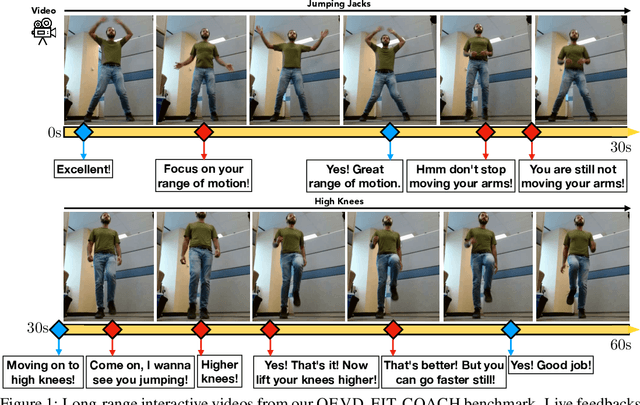



Abstract:Tasks at the intersection of vision and language have had a profound impact in advancing the capabilities of vision-language models such as dialog-based assistants. However, models trained on existing tasks are largely limited to turn-based interactions, where each turn must be stepped (i.e., prompted) by the user. Open-ended, asynchronous interactions where an AI model may proactively deliver timely responses or feedback based on the unfolding situation in real-time are an open challenge. In this work, we present the QEVD benchmark and dataset which explores human-AI interaction in the challenging, yet controlled, real-world domain of fitness coaching - a task which intrinsically requires monitoring live user activity and providing timely feedback. It is the first benchmark that requires assistive vision-language models to recognize complex human actions, identify mistakes grounded in those actions, and provide appropriate feedback. Our experiments reveal the limitations of existing state of the art vision-language models for such asynchronous situated interactions. Motivated by this, we propose a simple end-to-end streaming baseline that can respond asynchronously to human actions with appropriate feedbacks at the appropriate time.
EdgeRelight360: Text-Conditioned 360-Degree HDR Image Generation for Real-Time On-Device Video Portrait Relighting
Apr 15, 2024

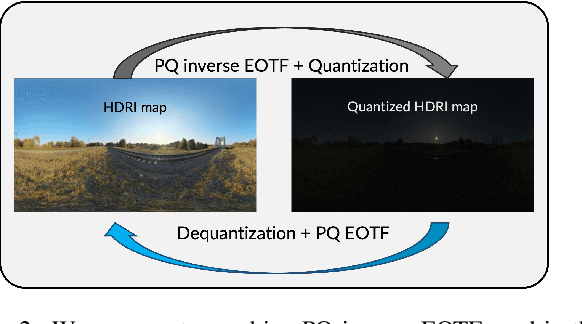

Abstract:In this paper, we present EdgeRelight360, an approach for real-time video portrait relighting on mobile devices, utilizing text-conditioned generation of 360-degree high dynamic range image (HDRI) maps. Our method proposes a diffusion-based text-to-360-degree image generation in the HDR domain, taking advantage of the HDR10 standard. This technique facilitates the generation of high-quality, realistic lighting conditions from textual descriptions, offering flexibility and control in portrait video relighting task. Unlike the previous relighting frameworks, our proposed system performs video relighting directly on-device, enabling real-time inference with real 360-degree HDRI maps. This on-device processing ensures both privacy and guarantees low runtime, providing an immediate response to changes in lighting conditions or user inputs. Our approach paves the way for new possibilities in real-time video applications, including video conferencing, gaming, and augmented reality, by allowing dynamic, text-based control of lighting conditions.
CC-VPSTO: Chance-Constrained Via-Point-based Stochastic Trajectory Optimisation for Safe and Efficient Online Robot Motion Planning
Feb 06, 2024Abstract:Safety in the face of uncertainty is a key challenge in robotics. We introduce a real-time capable framework to generate safe and task-efficient robot motions for stochastic control problems. We frame this as a chance-constrained optimisation problem constraining the probability of the controlled system to violate a safety constraint to be below a set threshold. To estimate this probability we propose a Monte--Carlo approximation. We suggest several ways to construct the problem given a fixed number of uncertainty samples, such that it is a reliable over-approximation of the original problem, i.e. any solution to the sample-based problem adheres to the original chance-constraint with high confidence. To solve the resulting problem, we integrate it into our motion planner VP-STO and name the enhanced framework Chance-Constrained (CC)-VPSTO. The strengths of our approach lie in i) its generality, without assumptions on the underlying uncertainty distribution, system dynamics, cost function, or the form of inequality constraints; and ii) its applicability to MPC-settings. We demonstrate the validity and efficiency of our approach on both simulation and real-world robot experiments.
HexaGen3D: StableDiffusion is just one step away from Fast and Diverse Text-to-3D Generation
Jan 15, 2024Abstract:Despite the latest remarkable advances in generative modeling, efficient generation of high-quality 3D assets from textual prompts remains a difficult task. A key challenge lies in data scarcity: the most extensive 3D datasets encompass merely millions of assets, while their 2D counterparts contain billions of text-image pairs. To address this, we propose a novel approach which harnesses the power of large, pretrained 2D diffusion models. More specifically, our approach, HexaGen3D, fine-tunes a pretrained text-to-image model to jointly predict 6 orthographic projections and the corresponding latent triplane. We then decode these latents to generate a textured mesh. HexaGen3D does not require per-sample optimization, and can infer high-quality and diverse objects from textual prompts in 7 seconds, offering significantly better quality-to-latency trade-offs when comparing to existing approaches. Furthermore, HexaGen3D demonstrates strong generalization to new objects or compositions.
Efficient neural supersampling on a novel gaming dataset
Aug 03, 2023Abstract:Real-time rendering for video games has become increasingly challenging due to the need for higher resolutions, framerates and photorealism. Supersampling has emerged as an effective solution to address this challenge. Our work introduces a novel neural algorithm for supersampling rendered content that is 4 times more efficient than existing methods while maintaining the same level of accuracy. Additionally, we introduce a new dataset which provides auxiliary modalities such as motion vectors and depth generated using graphics rendering features like viewport jittering and mipmap biasing at different resolutions. We believe that this dataset fills a gap in the current dataset landscape and can serve as a valuable resource to help measure progress in the field and advance the state-of-the-art in super-resolution techniques for gaming content.
Is end-to-end learning enough for fitness activity recognition?
May 14, 2023



Abstract:End-to-end learning has taken hold of many computer vision tasks, in particular, related to still images, with task-specific optimization yielding very strong performance. Nevertheless, human-centric action recognition is still largely dominated by hand-crafted pipelines, and only individual components are replaced by neural networks that typically operate on individual frames. As a testbed to study the relevance of such pipelines, we present a new fully annotated video dataset of fitness activities. Any recognition capabilities in this domain are almost exclusively a function of human poses and their temporal dynamics, so pose-based solutions should perform well. We show that, with this labelled data, end-to-end learning on raw pixels can compete with state-of-the-art action recognition pipelines based on pose estimation. We also show that end-to-end learning can support temporally fine-grained tasks such as real-time repetition counting.
QuickSRNet: Plain Single-Image Super-Resolution Architecture for Faster Inference on Mobile Platforms
Mar 08, 2023



Abstract:In this work, we present QuickSRNet, an efficient super-resolution architecture for real-time applications on mobile platforms. Super-resolution clarifies, sharpens, and upscales an image to higher resolution. Applications such as gaming and video playback along with the ever-improving display capabilities of TVs, smartphones, and VR headsets are driving the need for efficient upscaling solutions. While existing deep learning-based super-resolution approaches achieve impressive results in terms of visual quality, enabling real-time DL-based super-resolution on mobile devices with compute, thermal, and power constraints is challenging. To address these challenges, we propose QuickSRNet, a simple yet effective architecture that provides better accuracy-to-latency trade-offs than existing neural architectures for single-image super resolution. We present training tricks to speed up existing residual-based super-resolution architectures while maintaining robustness to quantization. Our proposed architecture produces 1080p outputs via 2x upscaling in 2.2 ms on a modern smartphone, making it ideal for high-fps real-time applications.
Fine-grained Video Classification and Captioning
Apr 24, 2018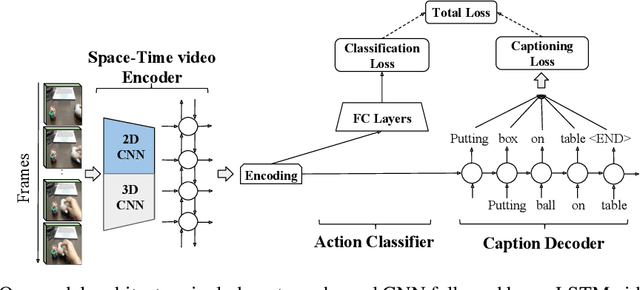
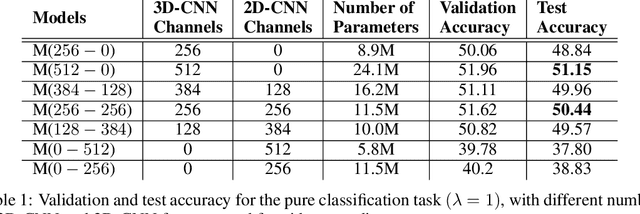
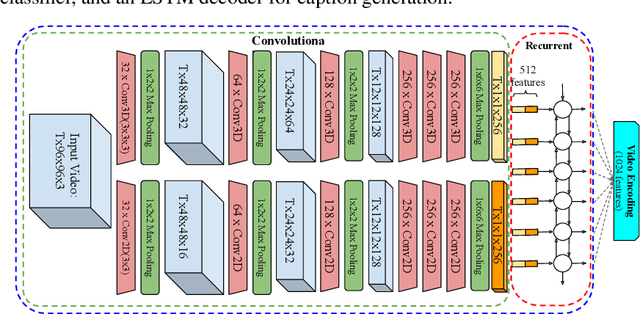

Abstract:We describe a DNN for fine-grained action classification and video captioning. It gives state-of-the-art performance on the challenging Something-Something dataset, with over 220, 000 videos and 174 fine-grained actions. Classification and captioning on this dataset are challenging because of the subtle differences between actions, the use of thousands of different objects, and the diversity of captions penned by crowd actors. The model architecture shares features for classification and captioning, and is trained end-to-end. It performs much better than the existing classification benchmark for Something-Something, with impressive fine-grained results, and it yields a strong baseline on the new Something-Something captioning task. Our results reveal that there is a strong correlation between the degree of detail in the task and the ability of the learned features to transfer to other tasks.
 Add to Chrome
Add to Chrome Add to Firefox
Add to Firefox Add to Edge
Add to Edge